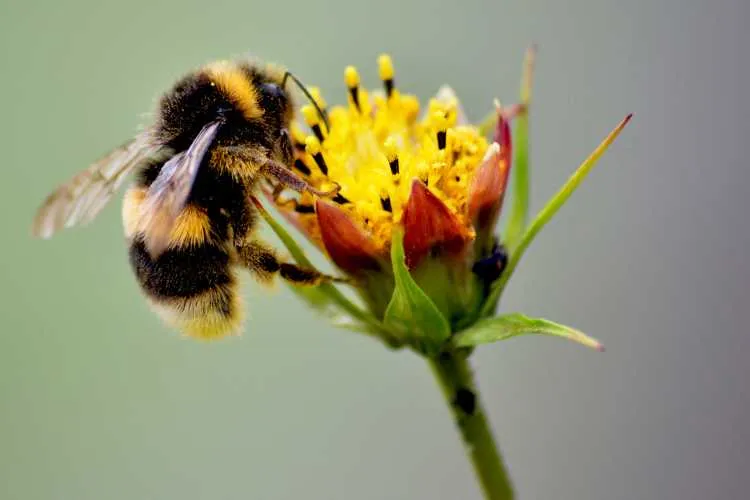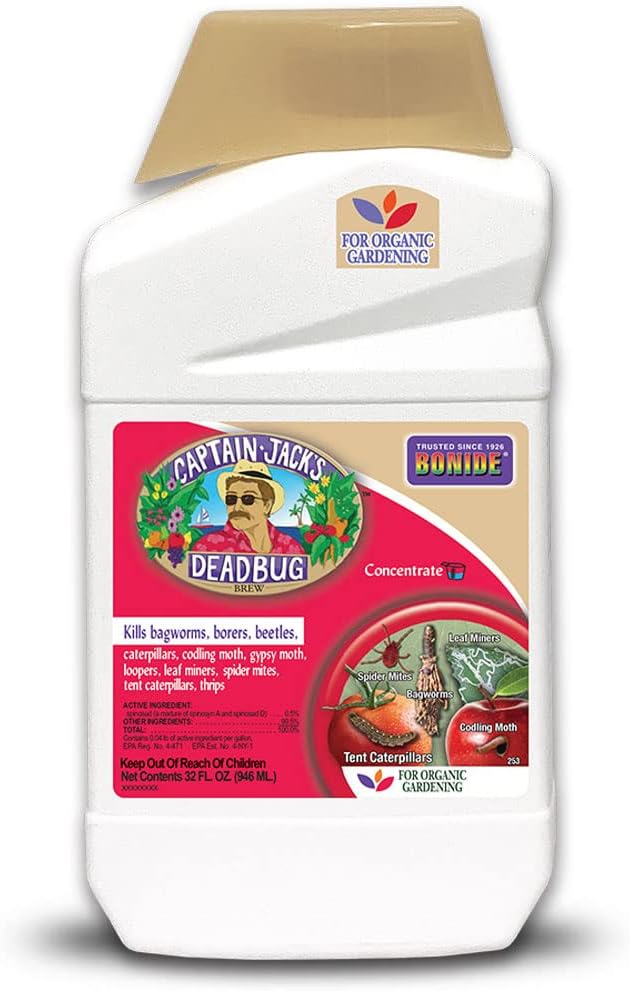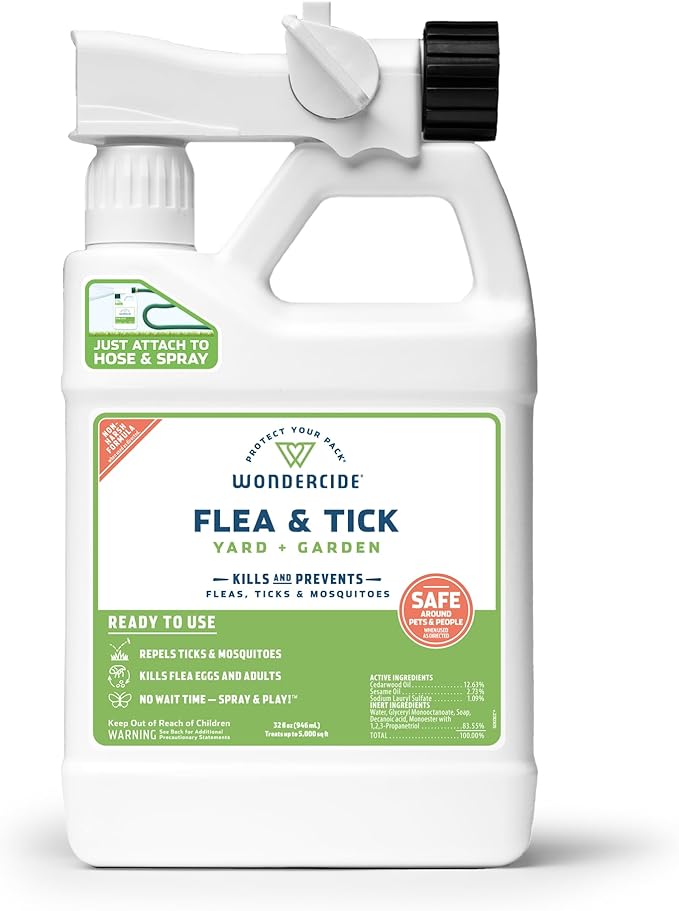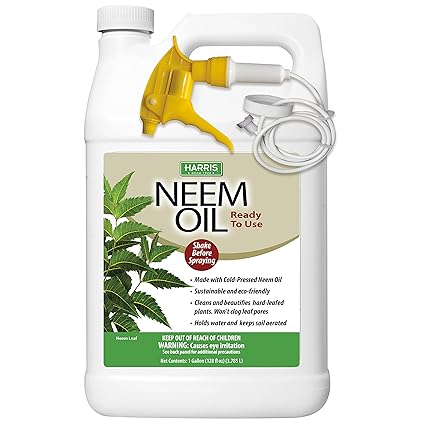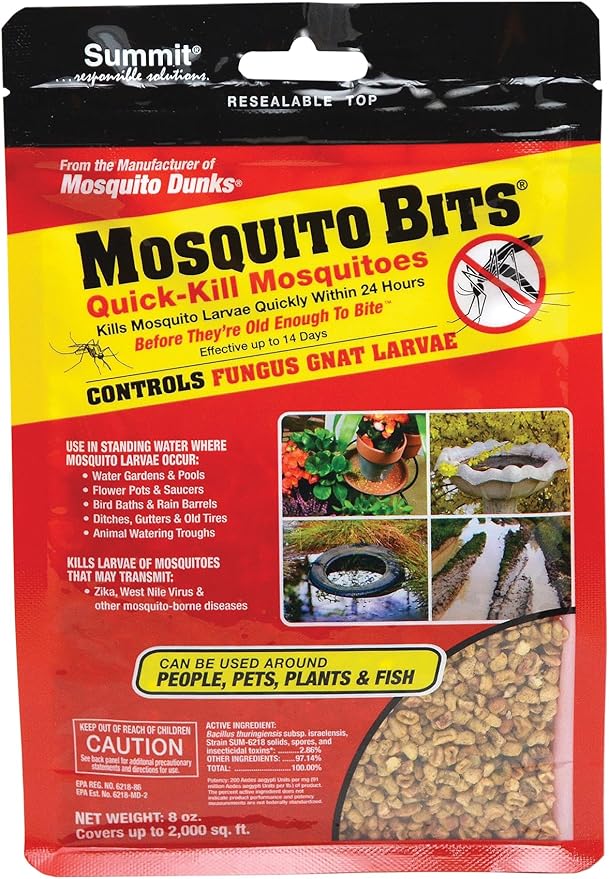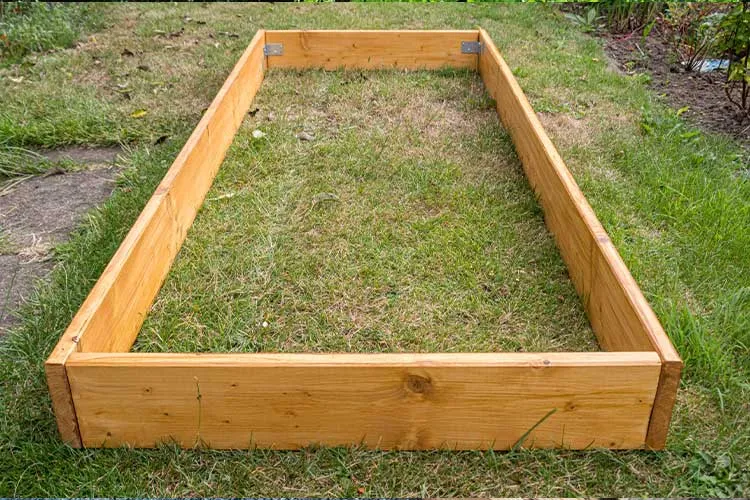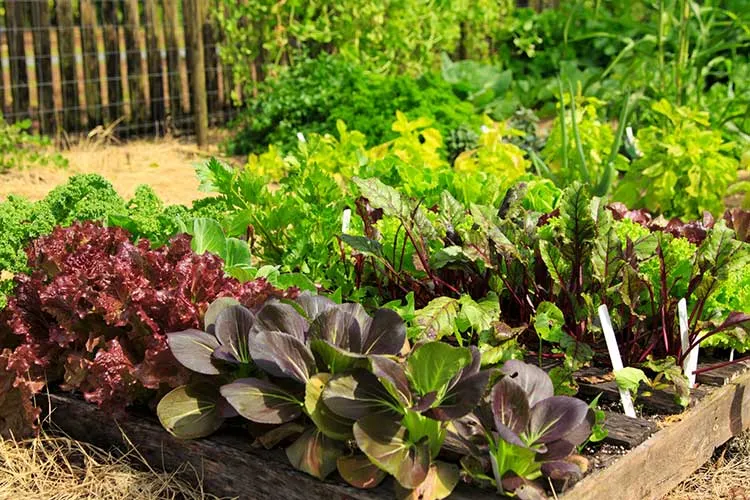You’re trying to protect your plants, but what if your spray silently wipes out bees, butterflies, and other pollinators? It happens more often than you think. Many insecticides labeled as “natural” or “eco-friendly” still contain ingredients that harm the very creatures your garden depends on.
If you’ve ever felt uneasy about spraying but didn’t know what else to use, you’re not alone. The risk is real, but there are safer choices. This guide will help you confidently choose a safe insecticide for pollinators—products that work without endangering the life in your garden.
No more guesswork. These proven options protect your plants and the pollinators who help them grow. Let’s get you the right tools.
12 Safe Insecticide for Pollinators
1. Neem Bliss 100% Cold-Pressed Neem Oil

Neem Bliss is a solid pick for an all-purpose solution that targets pests without messing with your garden’s natural balance. It’s especially effective on aphids, whiteflies, spider mites, and fungus gnats—common headaches for most gardeners.
The key ingredient is azadirachtin, found in cold-pressed neem oil. It disrupts insect feeding and reproduction, but breaks down quickly and is non-toxic to pollinators once dry. To use it, mix with water and a mild dish soap, then spray the solution on affected leaves and stems—just avoid blooms and active bee hours.
Pros:
- Doubles as a fungicide
- Safe for fruits, veggies, and ornamentals
- Biodegradable and plant-based
Cons:
- Strong earthy smell, some people dislike it
- Needs consistent application for best results
It’s a great starter option if you want something natural and adaptable across many plant types.
2. Safer Brand Insect Killing Soap
Safer Brand Insect Killing Soap is a great go-to for quick, spot treatments on soft-bodied pests like aphids, mealybugs, and whiteflies. It’s made with potassium salts of fatty acids, which break down insect cell membranes on contact—no lingering residue, no risk to pollinators after it dries.
You’ll get the best results by spraying it directly on the pests themselves, covering the undersides of leaves where they like to hide. It’s ideal for houseplants, vegetables, and herbs because it’s gentle, but still does the job.
Pros:
- Works fast and leaves no residue
- Breaks down quickly in the environment
- Approved for organic gardening
Cons:
- Needs reapplication after rain or watering
- Doesn’t work once dried—timing is everything
This one’s especially helpful when you want fast results without the stress of harming beneficial bugs.
3. Bonide Captain Jack’s Deadbug Brew
If caterpillars, thrips, or leafminers are chewing up your plants, Captain Jack’s Deadbug Brew might become your new favorite defense. The active ingredient here is spinosad, a naturally occurring bacteria-derived compound that targets chewing insects without harming bees, as long as you avoid spraying when they’re active.
After ingestion, it messes with the insect’s nervous system, so it’s best sprayed on foliage where pests feed. It’s a solid choice for fruit trees, vegetable gardens, and ornamentals.
Pros:
- Especially effective on hard-to-control caterpillars
- Approved for organic gardening
- Versatile across a wide range of crops
Cons:
- Should only be applied early morning or evening to protect pollinators
- Slight odor that may linger for a bit after spraying
This one’s a favorite among organic growers who need something with a serious bite—but not at the expense of the good guys.
4. Monterey BT (Bacillus thuringiensis)
If caterpillars and leaf-eating worms are your main issue, Monterey BT is one of the safest and most targeted ways to deal with them. The active ingredient, Bacillus thuringiensis kurstaki (Btk), is a naturally occurring soil bacterium that affects only caterpillar larvae, meaning bees, butterflies, and other insects won’t be harmed.
To use it, spray the solution on plant leaves where caterpillars feed. Once they ingest it, they stop eating and die within a few days. It’s ideal for brassicas, tomatoes, and ornamental plants prone to worm infestations.
Pros:
- Very targeted—won’t harm non-caterpillar insects
- Organic garden approved
- No harmful residue
Cons:
- Only works on larvae—won’t affect adult insects
- Needs to be reapplied regularly in heavy rain or after irrigation
This is a must-have if you’re dealing with caterpillar damage and want to simultaneously protect your flowering plants and pollinators.
5. Harris Diatomaceous Earth with Powder Duster
Harris Diatomaceous Earth is a classic choice for a long-lasting, chemical-free, non-spray option. It’s made from fossilized diatoms—microscopic algae that create a fine powder with sharp edges. When crawling insects like ants, beetles, or slugs come into contact with it, the particles damage their exoskeletons, causing them to dry out.
This version comes with a handy duster, making it easy to apply around plant bases, cracks, and garden borders. Remember that it only works when dry, so avoid watering the area immediately after applying.
Pros:
- Non-toxic to people, pets, and pollinators
- No chemicals or mixing needed
- Lasts a long time in dry areas
Cons:
- Stops working when wet
- Can look dusty on surfaces if over-applied
It’s especially useful if you prefer low-maintenance, no-mix options and want something safe to use in vegetable beds or kid-friendly spaces.
6. Wondercide Outdoor Pest Control Spray (Plant-Based)
If you’re dealing with flying pests like mosquitoes and flies but want something safe for pets, kids, and pollinators, Wondercide Outdoor Pest Control is a solid plant-based option. It uses essential oils like cedarwood and lemongrass to repel insects without synthetic chemicals, making it a great choice for gardens, patios, and lawn perimeters.
Hooking the bottle to your garden hose allows you to spray the yard, especially areas where mosquitoes and ants tend to hang out. The scent is strong at first but fades fairly quickly.
Pros:
- Safe around bees when used correctly
- No harsh chemicals or residue
- Family- and pet-friendly
Cons:
- Needs frequent reapplication, especially after rain
- Not ideal for targeting pests on plant foliage
This one shines as a perimeter spray—great for keeping bugs out of your garden zone without affecting the pollinators working inside it.
7. Trifecta Crop Control Ready-to-Use
Trifecta Crop Control might be worth a look if you need something that tackles pests and plant diseases while staying gentle on pollinators. This ready-to-use spray combines essential oils like thyme, clove, garlic, peppermint, and rosemary with citric acid to fight powdery mildew, spider mites, aphids, and more.
It’s designed for foliar spraying—give the bottle a good shake and coat both sides of the leaves. It’s effective as both a treatment and a preventative, especially useful in warm, humid conditions where fungal issues are common.
Pros:
- Works on pests and mildew
- Pleasant herbal scent
- Safe for use up to the day of harvest
Cons:
- Pricier than most insecticides
- The bottle may not last long in larger gardens
If you’re managing a small to medium garden and want an all-in-one spray that’s safe and easy to apply, this one makes the job simple.
8. Mighty Mint Insect and Pest Control Spray
Mighty Mint is a great natural choice when you need something that smells good, works fast, and won’t put pollinators at risk. Its main ingredient is pure peppermint oil, which repels ants, spiders, flies, and even mice, without harming bees or butterflies.
It’s most effective as a perimeter spray or for indoor/outdoor use around doors, windows, and containers. Just mist it wherever bugs like to sneak in. While it doesn’t kill pests on contact, it strongly discourages them from sticking around.
Pros:
- Refreshing scent and safe to use around the home
- No synthetic chemicals
- Great for potted plants, patios, and greenhouses
Cons:
- Needs frequent reapplication outdoors
- Not effective for infestations—more of a deterrent
This one’s a favorite for gardeners who like a light touch and want to keep bugs at bay without risking pollinator health.
9. Garden Safe Insecticidal Soap
Garden Safe Insecticidal Soap is a reliable staple for a gentle but effective pest control option that won’t harm bees or butterflies. Like others in its category, it uses potassium salts of fatty acids to target soft-bodied insects such as aphids, whiteflies, and spider mites. It works on contact by breaking down their outer shells, which leads to dehydration with no residue or long-term impact.
It’s perfect for vegetables, houseplants, herbs, and flowers. Spray it directly onto the pests, being sure to reach the undersides of leaves where they often hide.
Pros:
- Breaks down quickly—safe for pollinators once dry
- No synthetic chemicals
- Works well indoors and out
Cons:
- Must be reapplied after rain or overhead watering
- Needs direct contact with pests to be effective
This is a great everyday product for small infestations, especially if gardening with pollinator safety in mind.
10. Harris Neem Oil Ready-to-Use Spray
If you like the idea of neem oil but don’t want the hassle of mixing it yourself, Harris Neem Oil Ready-to-Use is a convenient, beginner-friendly option. It comes pre-diluted with water and a mild emulsifier so that you can shake and spray. The active ingredient is cold-pressed neem oil, which targets pests like fungus gnats, spider mites, and scale insects while staying safe for pollinators after it dries.
It’s best used as a preventive or for early-stage infestations. Spray on foliage weekly or biweekly, avoiding blooms and peak pollinator activity times.
Pros:
- No mixing required—easy for beginners
- Organic gardening approved
- Safe around pets and beneficial insects when dry
Cons:
- Less potent than concentrated neem oil
- May require more frequent applications
This is a great fit for smaller gardens, houseplants, or anyone wanting a grab-and-go option with minimal prep.
11. Earth’s Ally Insect Control Spray
Earth’s Ally Insect Control checks all the boxes if you’re looking for a clean-label insect spray that’s safe for pollinators and packed with natural ingredients. It’s made with rosemary, clove, and peppermint oils, and designed to knock down soft-bodied pests like aphids, mites, and whiteflies without harming the bees and butterflies that visit your plants.
It’s a ready-to-use spray for houseplants, vegetables, and ornamentals. Spray thoroughly, especially on the undersides of leaves, and repeat weekly or as needed.
Pros:
- No synthetic ingredients
- Safe for use around kids and pets
- Pleasant, herbal scent
Cons:
- The bottle won’t go far in larger gardens
- Ongoing use is needed to keep pests under control
It’s a solid option for indoor growers or smaller beds where control and consistency matter more than large-volume coverage.
12. Summit Mosquito Bits
If you’re battling fungus gnats or mosquito larvae in standing water or soil, Summit Mosquito Bits are a pollinator-safe way to stop them at the source. These granules contain Bacillus thuringiensis israelensis (Bti)—a naturally occurring bacterium that specifically targets insect larvae without harming adult insects, pollinators, pets, or people.
You sprinkle the bits over soil in potted plants, raised beds, or compost, or toss them into standing water like birdbaths or rain barrels. They’ll break the life cycle before pests can mature and spread.
Pros:
- Kills larvae fast without harming bees or butterflies
- Easy to use—sprinkle and go
- Works in soil and water
Cons:
- Only works on larvae, not adult flying insects
- Needs reapplication every 7–14 days
This is a great backup tool for mosquito-prone areas or indoor plants where gnats thrive.
Why Choosing the Right Insecticide Matters
If you care about your garden, chances are you also care about the bees, butterflies, and other beneficial insects that make it thrive. But here’s the catch—many off-the-shelf insecticides don’t just target pests. They can also harm pollinators, sometimes fatally. Even well-meaning gardeners accidentally disrupt pollinator populations by spraying during blooming hours or choosing chemical-heavy formulas that linger long after pests are gone.
Healthy pollinator numbers mean better fruit set, stronger vegetables, and vibrant flower beds. So every choice you make—especially regarding pest control—has a ripple effect. The wrong spray could wipe out your garden’s biggest helpers, while a safe insecticide for pollinators can knock out pests and keep bees buzzing.
Using pollinator-safe insecticides is about more than gardening success. It’s about doing the right thing for your plants, soil, and pollinators’ future everywhere.
What to Look for in a Safe Insecticide for Pollinators
Not all insecticides are created equal; details matter when pollinators are involved. Start by checking the label—OMRI-listed or certified organic products usually use naturally derived ingredients that break down quickly and target pests without lingering in the environment.
Avoid anything with neonicotinoids, which are long-lasting and deadly to bees even in small doses. Also, avoid broad-spectrum insecticides that kill on contact without distinguishing between harmful and helpful bugs. Instead, opt for contact-based sprays that break down quickly or target specific pests.
Look for ingredients like neem oil, spinosad, or Bacillus thuringiensis (Bt)—when applied properly, these work on pests while sparing pollinators. Timing is also key: spray early in the morning or late evening, when bees and butterflies are least active. And always avoid spraying directly on blooms—flowers are a pollinator’s workplace, and they need safe access to do their job.
Bonus Tips for Safe Use of Insecticides Around Pollinators
Even the safest insecticide can become harmful if it’s used incorrectly. Timing is everything—spray in the early morning or late evening, when bees and butterflies are least active. This reduces direct contact and gives sprays time to dry before pollinators return.
Avoid spraying flowers or open blooms where pollinators feed. Instead, target the leaves, stems, and soil, where pests live and feed. If treating a flowering plant, try shielding the blooms with a cloth or gently rinsing them afterward with water.
Rotate your pest control methods to reduce the risk of resistance, and consider using physical barriers like row covers for delicate crops.
Finally, always follow the product label. More isn’t better; overuse can lead to runoff and long-term soil issues. Used thoughtfully, these insecticides let you strike the balance between protecting your garden and preserving the pollinators that help it thrive.

